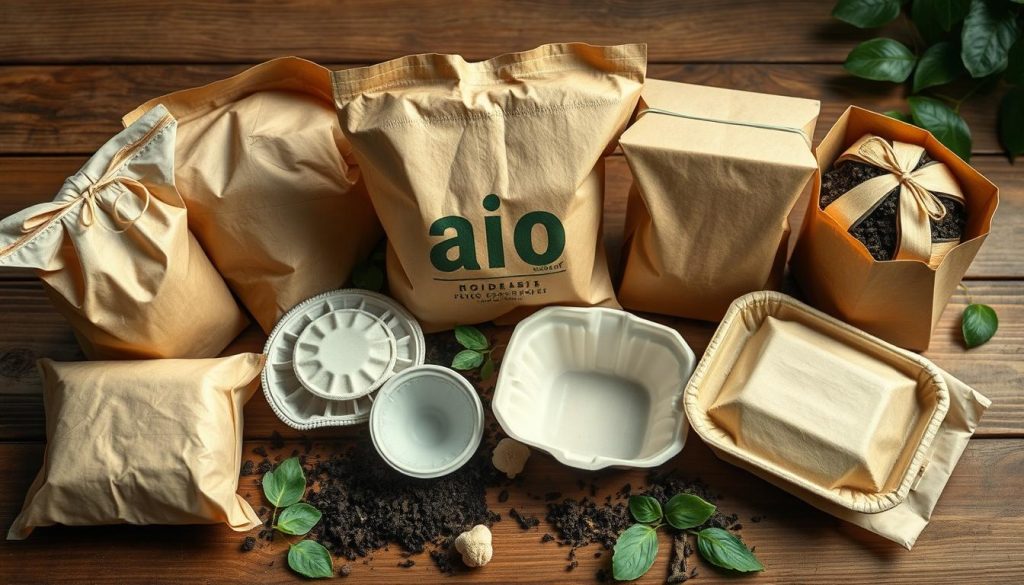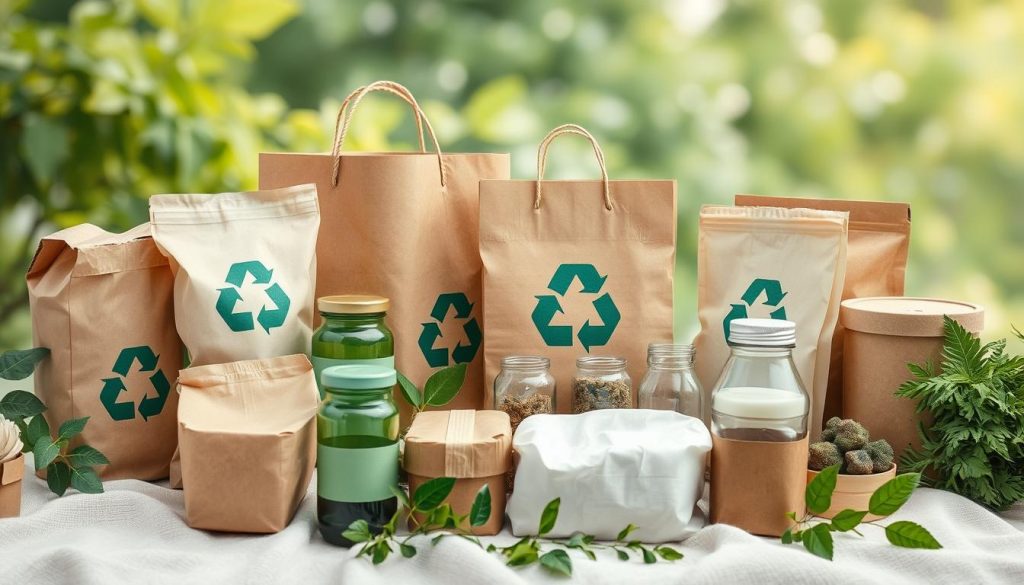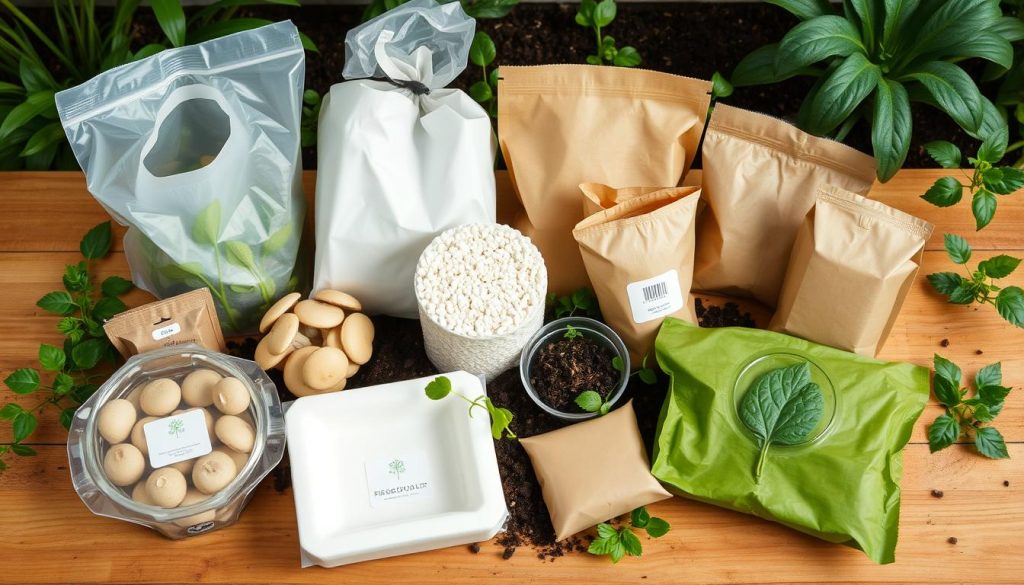I’ve seen a big change in packaging lately. Eco-friendly packaging is now a key focus for both businesses and consumers. This move towards green solutions is crucial for our planet’s health.
The need for eco-friendly packaging has grown a lot. Companies are changing their packaging to be better for the environment. They’re using biodegradable and recyclable materials, leading to a big growth in eco-friendly options.
In this article, we’ll look at different sustainable materials used in packaging. We’ll see how these green choices are changing the industry. Let’s explore the new, earth-friendly ways of packaging together.
The Rise of Sustainable Packaging in Modern Commerce
In recent years, the packaging industry has seen a big change. Companies are now using sustainable packaging instead of old methods. This change is because of several reasons that are changing how we package products.
Environmental Impact of Traditional Packaging
Traditional packaging harms the environment a lot. Single-use plastics fill our oceans and landfills, taking centuries to break down. These plastics and other non-biodegradable materials pollute and hurt animals. Making these materials also increases carbon emissions, making climate change worse.
Consumer Demand for Eco-Friendly Alternatives
People are now more aware of the environment. They want eco-friendly options and choose them when they can. This change in what people want is making companies rethink their packaging. Brands that use sustainable packaging are doing better in the market.
Corporate Responsibility and Sustainability Goals
Companies are seeing their part in taking care of the environment. Many are setting big goals to reduce their carbon footprint and waste. Sustainable packaging is a big part of these goals. By using eco-friendly packaging, businesses meet what customers want and help the planet.
| Traditional Packaging | Sustainable Packaging |
|---|---|
| High environmental impact | Reduced environmental impact |
| Often non-recyclable | Recyclable or biodegradable |
| Contributes to pollution | Minimizes waste and pollution |
The move to sustainable packaging in modern commerce is a big step. It shows we’re all aware of our planet’s needs and working together for a greener future.
Understanding Eco-Friendly Packaging Materials
I’ve found out that eco-friendly packaging is changing how we protect and move goods. These materials come in different types, each with special benefits for our planet.
Biodegradable packaging breaks down naturally over time. It’s made from organic stuff that bugs can eat, helping to cut down landfill waste. You can find everything from plant-based plastics to mushroom packaging in this group.
Recyclable packaging is also a big deal. These items can be made into new things, saving resources. Glass, metal, and some plastics are common examples. Always look for recycling symbols to make sure you dispose of it right.
Compostable packaging goes even further. It turns into soil that’s full of nutrients. Many food containers and bags are now made from compostable stuff, helping to reduce food waste.
| Packaging Type | Environmental Impact | Common Uses |
|---|---|---|
| Biodegradable | Reduces landfill waste | Food containers, shopping bags |
| Recyclable | Conserves resources | Bottles, cans, cardboard boxes |
| Compostable | Creates nutrient-rich soil | Food packaging, disposable cutlery |
Choosing the right eco-friendly packaging depends on the product and its life cycle. It’s important to think about shelf life, how it’s moved, and how it’s thrown away when picking sustainable packaging.
Biodegradable Packaging: Nature’s Way of Disposal

Biodegradable packaging is changing how we see product containers. More people are looking for eco-friendly options due to environmental concerns. Let’s dive into the world of biodegradable materials and how they help reduce waste.
Types of Biodegradable Materials
Today, we have many biodegradable packaging materials. Some popular ones are:
- Starch-based plastics
- Cellulose-derived packaging
- PLA (Polylactic Acid)
- PHA (Polyhydroxyalkanoates)
Decomposition Process and Timeframes
The breakdown time of biodegradable packaging depends on the material and where it’s used. These materials decompose naturally with the help of microorganisms, heat, and moisture. The time it takes can be anywhere from a few months to several years.
| Material | Decomposition Time | Environmental Conditions |
|---|---|---|
| Starch-based plastics | 3-6 months | Industrial composting |
| PLA | 6-24 months | Industrial composting |
| Cellulose-derived | 1-5 years | Varies |
| PHA | 3-6 months | Marine environments |
Benefits and Limitations
Biodegradable packaging has big environmental pluses, like less waste in landfills and lower carbon emissions. But, it’s key to dispose of them right for them to break down well. Some downsides include higher costs to make and the risk of polluting recycling if not thrown away correctly.
Recyclable Packaging: Giving Materials a Second Life

I’ve noticed a big trend in recyclable packaging. It’s amazing to see how these materials get a second chance. This trend is key to cutting down waste and saving resources. Many items like paper, glass, and some plastics can be made into new things through recycling.
The recycling process changes based on the material. Paper gets pulped and reformed. Glass is melted and remolded. Plastics go through a detailed process, sorted, cleaned, and melted to make new items. It’s cool to see how these materials can be used over and over again.
There’s also a rise in plastic-free packaging. Companies are choosing cardboard, glass, and metal instead. These are better for the environment and easier to recycle. They also have higher recycling rates and are processed more efficiently.
| Material | Recycling Rate | Energy Saved |
|---|---|---|
| Aluminum | 34.1% | 95% |
| Paper | 65.7% | 40% |
| Glass | 31.3% | 30% |
| Plastic | 8.7% | 70% |
Recyclable packaging has many benefits, but there are still challenges. Not all materials can be recycled easily, and contamination can stop the process. As consumers, we help by sorting and cleaning our waste properly before throwing it away.
Compostable Packaging: From Waste to Resource

Compostable packaging is changing how we see waste. I’ve seen how these materials naturally break down, leaving no bad stuff behind. Let’s dive into the world of compostable packaging and how it can change our sustainability game.
Industrial vs. Home Compostable Materials
Industrial compostable materials need special conditions to decompose. They need high heat and a controlled setting, like big facilities. Home compostable items, however, can break down in your backyard bin. Knowing the difference is key for the right disposal and less harm to the environment.
Certification Standards for Compostable Packaging
Certification standards make sure compostable packaging meets certain rules. These rules check if materials fully break down without harming the environment. Look for labels like ASTM D6400 and EN 13432 when picking compostable products.
| Certification | Focus | Timeframe |
|---|---|---|
| ASTM D6400 | Industrial composting | 180 days |
| EN 13432 | European standard | 12 weeks |
| AS 5810 | Home composting | 26 weeks |
Best Practices for Composting Packaging
To compost packaging right, follow these tips:
- Check for certification labels
- Separate compostable items from regular trash
- Cut bigger pieces into smaller bits
- Keep your compost pile moist and at the right temperature
- Mix compostable packaging with other organic stuff
By following these tips, we can get the most out of compostable packaging. This helps us move towards a greener future.
Paper-Based Packaging: A Versatile Eco-Option
Paper-based packaging is becoming more popular as a green alternative. I’ve seen a big change towards these eco-friendly choices. Many companies are now using paper-based solutions to lessen their environmental footprint and meet the demand for eco-friendly packaging.
One big plus of paper-based packaging is its flexibility. It works for many products, from food to electronics. It’s also light, affordable, and can be tailored to fit different needs. Plus, it breaks down easily and can be recycled, making it a favorite for those who care about the planet.
Here are some common types of paper-based packaging:
- Corrugated boxes
- Paperboard cartons
- Kraft paper bags
- Molded pulp containers
These materials are strong and last long while being kind to the environment. The making of paper-based packaging often uses recycled fibers, cutting down on carbon emissions. With ongoing improvements, we’re seeing new features like water-resistant coatings and better barrier properties.
By picking paper-based packaging, businesses can cut down on plastic waste and attract eco-aware customers. It’s good for both the planet and their profits. As we strive for a greener future, paper-based packaging is showing itself to be a smart and eco-friendly option for many sectors.
Plant-Based Plastics: The Future of Packaging?
I’m excited about plant-based plastics as a potential game-changer in eco-friendly packaging. These innovative materials offer a promising alternative to traditional petroleum-based plastics. They align with the growing demand for sustainable solutions.
Types of Plant-Based Plastics
Plant-based plastics come in various forms, each with unique properties. Some common types include:
- PLA (Polylactic Acid): Made from corn starch or sugarcane
- PHA (Polyhydroxyalkanoates): Produced by microorganisms
- Starch-based plastics: Derived from potatoes, corn, or wheat
Production Processes and Environmental Impact
The production of plant-based plastics involves fermenting plant sugars to create polymers. This process generally has a lower carbon footprint compared to traditional plastic manufacturing. While not perfect, these materials contribute to reducing our reliance on fossil fuels. They can be part of a zero-waste packaging strategy.
Challenges and Opportunities in the Market
Despite their potential, plant-based plastics face hurdles. Cost and scalability remain significant challenges. Consumer education is crucial, as many people are unfamiliar with proper disposal methods. On the bright side, growing environmental awareness is driving demand for sustainable packaging solutions. This creates opportunities for innovation and market growth in the plant-based plastics industry.
Zero-Waste Packaging: Minimizing Environmental Footprint
Zero-waste packaging is changing how we think about product containers. There’s a growing trend towards plastic-free solutions that aim to eliminate waste. This method focuses on reusable and refillable systems, keeping materials in use forever.
Many companies are adopting new zero-waste strategies. Some grocery stores have bulk sections where customers bring their own containers. This cuts out single-use packaging. Online stores are also trying reusable shipping boxes that customers return after use.
Zero-waste packaging has big benefits. It cuts down landfill waste, saves resources, and can save money too. As a consumer, choosing products with less environmental impact feels empowering.
| Zero-Waste Packaging Type | Benefits | Challenges |
|---|---|---|
| Reusable containers | Eliminates single-use waste | Requires customer participation |
| Bulk dispensers | Reduces packaging waste | Limited product selection |
| Edible packaging | 100% waste-free | Short shelf life |
As zero-waste packaging grows, I’m looking forward to new ideas. From edible wrappers to packaging-free stores, the future looks bright. By supporting these efforts, we can all help reduce our environmental impact.
Eco-Friendly Packaging: Balancing Sustainability and Functionality
I’ve noticed a trend towards eco-friendly packaging. It aims to be both green and useful. Companies are making packaging that protects products and is good for the planet. This is great because it shows we can have effective and eco-friendly packaging.
I’ve found some cool eco-friendly packaging ideas. For instance, some brands use plant-based materials that are as good as plastic but biodegradable. Others have reusable containers that reduce waste and keep products fresh.
The future of eco-friendly packaging looks promising. We’ll see more edible packaging and designs that adapt to the environment. As consumers, we can help by choosing products with green packaging. Let’s support sustainable options in our daily lives.

